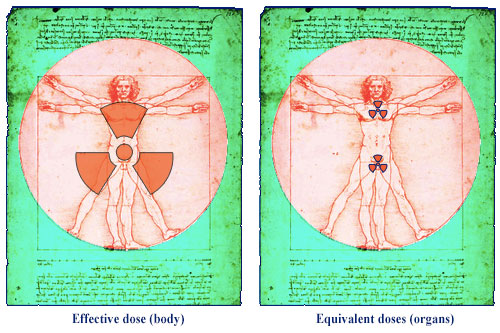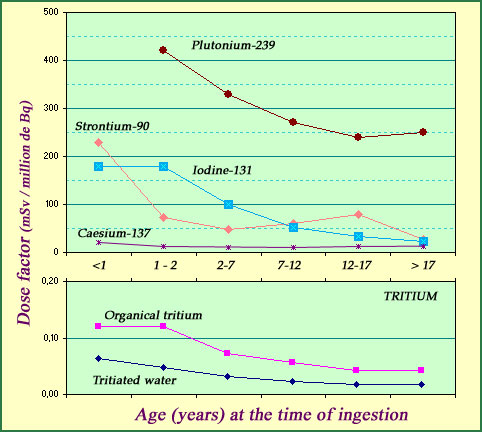From radioactive activity to biological doses
Radioactivity is invisible, inaudible and cannot be felt. In order to protect ourselves from this ‘hidden’ phenomenon, we have to be able to detect it, understand how it affects us, and evaluate what constitutes a harmful dose.

Effective dose and equivalent dose:
One should distinguish between two types of absorbed doses. When the entire body is exposed, as is the case with sources external to the body, exposure is measured in terms of the ‘effective dose’ – the global dose absorbed by the body. By contrast, when the exposure is limited to a specific organ (as it occurs in therapy or, say, an accident), the relevant dose is the ‘equivalent dose’, which is calculated by taking the amount of energy absorbed locally and the nature of the radiation into account.
© Léonard de Vinci : Homme de Vitruve
Experts distinguish between three types of radioactive and more generally radiations dose:
– Activity, or the number of disintegrations occurring per second,
– Amount of energy deposited locally by a radiations ,
– Biological dose, which takes into account the effect of radiation on living tissue.
Activity is a measure of the number of disintegrations occurring in a radioactive source every second – which is to say how many rays are emitted in that time. The units of activity are known as becquerels (Bq), where 1 Bq is the activity of a substance that has one nucleus decaying per second. Obviously, becquerels are tiny units, and as a result kilo- (kBq), mega- (MBq) and giga- (GBq) becquerels are more frequently used. Even though radioactivity is a good measure of the intensity of a source, this decay count reveals nothing about the energy each disintegration releases, or how harmful the emitted radiation can be.
In calculating the amount of energy coming from a radioactive source and absorbed by living tissue, a number of factors need to be considered. The most important of these are the proximity to the source and the obstacles the radiations have to pass through to reach their target.
If one kilogram of matter absorbs one joule of radiated energy, it is said to have absorbed a dose of 1 gray (1 Gy). In contrast to the Bq, this is a particularly large unit, and so the use of milligrays (mGy) is more common. It is measurements in milligrays that are used in medicine to determine safe and effective strengths for radiation therapy.

Sensitivity as a function of age
Sensitivity to radiation is dependent on age. This graph shows the variation of the effective dose released by the ingestion of a million becquerels for some relevant radioactive elements. While all living cells have a certain regenerative power, those of babies and young children, which are regenerated rapidly, are much more sensitive to radiations than those of adult. The comparative toxicities (known as dose factors) vary also enormously from one element to another. Most damaging of all are alpha-emitters, represented here by plutonium. The radioactive toxicity of tritium on the contrary is so low that it had to be drawn on a separate scale.
© IN2P3
The biological doses, though the most important of the three, are the hardest to evaluate accurately. The main reason for this difficulty is that an accurate evaluation involves a number of factors: the path taken by the radioactive elements inside the body, the type of ray emitted and the comparative danger posed by these types of rays.
The biological doses are expressed in sieverts (Sv) or millisieverts (mSv). The main biological dose, the effective dose, is a way of expressing the real physiological significance of an exposure for the entire body. To calculate the effective biological dose in sieverts from the absorbed doses (in grays), one has to apply a series of factors that account for the radiation type, the duration of the exposure, and the parts of the body that were exposed.
In radiotherapy, elevated doses of radiation are concentrated locally over short periods of time, which is more harmful to the targeted cells. To be able to determine the precise length of time needed, a concept known as the ‘equivalent dose’ has been introduced. This is a dose which multiplies the absorbed dose (in grays) in an organ or tissue by a ‘weighting factor’ specific to the type of radiation involved: a value which differs depending on the part of body being discussed.
The ‘effective dose’ is more useful in discussing exposure on the entire body and evaluating the corresponding risks. Examples of ‘effective dose’ are the doses resulting from a year exposure to natural radioactivity, radioactivity encountered in the workplace, radiation emitted by medical testing and finally accidental exposure to radioactivity (such as the remnants of the Chernobyl disaster, which amounts to around 0.019 mSv per person per year in Western Europe).
Articles on the subject « Radioactive Doses »
Radioactive Activity Doses
Becquerel or Bq : the activity unit of a radioactive source The activity of a sample of matter wh[...]
Absorbed doses
Gray or Gy : unit of energy deposited in matter by radiation The ‘absorbed dose’ is defined as th[...]
Biological doses
Sievert (Sv) : the unit of doses for the living The energy deposited in a living organism by radi[...]
Equivalent Dose
A local biological dose The concept of the « equivalent dose » which takes into account the natur[...]
Effective Dose
A full-body dose, central in the field of radioprotection The « effective dose » is a biological [...]
MilliSievert
A unit for low doses of radioactivity After a nuclear accident or accident of radioactivity, it i[...]
Dose Scale
A dose classification for acute exposures When dealing with exposure to radiations, what do we me[...]